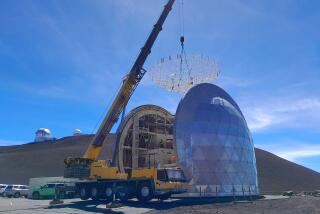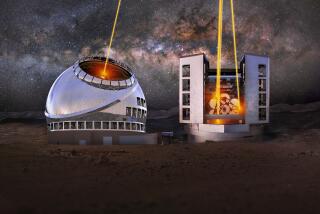Astronomical gem atop Mt. Wilson
A century ago, the tranquil air above Mt. Wilson was an astronomer’s dream. Not yet polluted by light from the developing communities below, the 5,800-foot-high peak in the San Gabriel Mountains was ideal for observing the universe.
From the famed observatory that sits atop the pine-covered mountain, some of the greatest astronomical discoveries of the 20th century were made.
It is where Nobel laureate Albert Michelson determined the speed of light, Edwin Hubble proved that the universe was expanding, and where, 100 years ago last month, observatory founder George Ellery Hale discovered magnetic fields on the sun.
But as Los Angeles grew, the nighttime glow of urbanization drove astronomers to the darker skies of Hawaii, Arizona and Chile. Mount Wilson Observatory’s scientific importance shrank.
By the mid-1980s, the mighty 100-inch telescope used by Hubble was gathering dust and the entire observatory was on the verge of becoming a relic of astronomy’s past.
Today, Mount Wilson appears ready to again play a key role in ground-based astronomy. It has become a testing ground for newly perfected technology that allows astronomers to study neighboring stars despite the glare of city lights.
“It’s almost a temple to astronomical history and current research,” said Jack Harvey, an astronomer at the National Solar Observatory at Kitt Peak, Ariz.
The mountain’s original scientists scaled its steep slopes for its unsurpassed “seeing” -- what astronomers call the clear views that result from the combination of dark skies and steady air. Ironically, the inversion layer that keeps smog trapped over Los Angeles is a blessing for stargazers because it reduces the atmospheric turbulence that causes stars to twinkle and blurs astronomical images.
Hale established the observatory in 1904 with backing from the Carnegie Institution for Science to test his theory that magnetic fields existed on the sun. Despite perfect sky conditions, his early efforts ran into a problem that Hale hadn’t anticipated.
“The sun would heat the Earth enough that convection currents rising right from the ground itself would distort the image,” said Edward Rhodes, a professor of astronomy at USC.
Hale’s solution was to construct a 60-foot solar tower high enough to avoid interference from heat waves. Then, by comparing the spectrum of light from a sunspot to that of regular sunlight, he found the unmistakable signature of a magnetic field -- the first observed beyond Earth.
Hale’s discovery kick-started the field of solar science, in which Mount Wilson remained a leader for 50 years.
“In our field they call it the Mount Wilson era,” Harvey said.
Hale also had an eye to the stars and arranged to install first a 60-inch telescope and then the 100-inch telescope -- the world’s largest at the time.
Getting the equipment to the observatory was an ordeal. There was a railroad station in Pasadena, but from there it was a two-day journey by mule train to take supplies and workers up a narrow path to the facility.
The effort was well worth it because more discoveries followed.
Using the 60-inch telescope -- so named because its light-gathering mirror is 60 inches in diameter -- the astronomer Harlow Shapley showed that our solar system was not the center of the Milky Way galaxy.
In 1919, astronomer Hubble, using the newly completed 100-inch telescope, discovered that faint details in the night sky were galaxies beyond our own. His finding a few years later that the universe was expanding was possibly astronomy’s greatest achievement of the 20th century.
But in the latter half of the century, scientists turned their focus toward deep-space exploration, which required dark skies. In 1986, the Carnegie Institution, which owned the observatory, decided to close it.
Coming to its rescue was the Mount Wilson Institute, a nonprofit formed by concerned scientists who persuaded the Carnegie Institution to give them responsibility for the observatory’s operation and finances.
The group sought out new projects that, like solar research, take advantage of the mountain’s steady air.
One involves interferometry, in which light pooled from small, strategically placed telescopes looks as if it came from a single, gargantuan telescope.
The observatory now has two of these interferometers. The largest, which is run by the Center for High Angular Resolution Astronomy at Georgia State University, consists of six telescopes and can mimic a telescope lens a quarter-mile in diameter -- enough sensitivity to pick out a dime on the sidewalk in Atlanta, more than 2,200 miles away.
As in its early days, research into the sun shines brightly at Mount Wilson. The facility is one of the few worldwide involved in helioseismology, the study of shaking on the sun that is much like earthquakes.
Rhodes’ group analyzes patterns of shaking to deduce what is going on deep in the sun’s interior. The internal movements are intimately connected to the magnetic cycles that produce sunspots.
He hopes their work will lead to a better understanding of the relationship between the magnetic fields in the sun and the weather on Earth.
Working at the original solar tower, the scientists begin each day with a century-old ritual: adding a new photograph of the sun to Mount Wilson’s uninterrupted archive.
--






